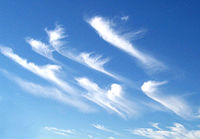
Photo from wikipedia
In this study, the generation of airfoil trailing edge broadband noise that arises from the interaction of turbulent boundary layer with the airfoil trailing edge is investigated. The primary objectives… Click to show full abstract
In this study, the generation of airfoil trailing edge broadband noise that arises from the interaction of turbulent boundary layer with the airfoil trailing edge is investigated. The primary objectives of this work are: (i) to apply a wall-modelled large-eddy simulation (WMLES) approach to predict the flow of air passing a controlled-diffusion blade, and (ii) to study the blade broadband noise that is generated from the interaction of a turbulent boundary layer with a lifting surface trailing edge. This study is carried out for two values of the Mach number, $${{\rm Ma}}_{\infty } = 0.3$$ Ma ∞ = 0.3 and 0.5, two values of the chord Reynolds number, $${{\rm Re}}=8.30 \times 10^5$$ Re = 8.30 × 10 5 and $$2.29 \times 10^6$$ 2.29 × 10 6 , and two angles of attack, AoA $$=4^\circ$$ = 4 ∘ and $$5^\circ$$ 5 ∘ . To examine the influence of the grid resolution on aerodynamic and aeroacoustic quantities, we compare our results with experimental data available in the literature. We also compare our results with two in-house numerical solutions generated from two wall-resolved LES (WRLES) calculations, one of which has a DNS-like resolution. We show that WMLES accurately predicts the mean pressure coefficient distribution, velocity statistics (including the mean velocity), and the traces of Reynolds tensor components. Furthermore, we observe that the instantaneous flow structures computed by the WMLES resemble those found in the reference WMLES database, except near the leading edge region. Some of the differences observed in these structures are associated with tripping and the transition to a turbulence mechanism near the leading edge, which are significantly affected by the grid resolution. The aeroacoustic noise calculations indicate that the power spectral density profiles obtained using the WMLES compare well with the experimental data.
Journal Title: Scientific Reports
Year Published: 2020
Link to full text (if available)
Share on Social Media: Sign Up to like & get
recommendations!